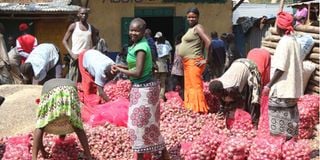Premium
Maturity and curing of the bulb onions

Women pack onions into nets in Ortum, West Pokot County, before the produce is transported to other towns for sale. It is important for the onions to be sold once cured.
Every crop has a cycle that has to be completed for it to be considered mature. Onions take three to four months to reach maturity.
This depends on variety and the environmental conditions the crop was grown.
In farmer Desmond’s case, the crop is almost mature since the leaves have started drying and he has achieved the desired bulb size. In this article, look at curing and the maturity indices of onions.
Maturity refers to the point at which the onion has reached its full size and has completed its growth cycle, hence ready for harvest.
The maturity of an onion can be determined by observing its tops or necks. As the onion grows and matures, the tops start to dry out and turn brown.
The necks of the onions also begin to soften and bend.
Also Read: Downey mildew in the onion crop
The onions are ready for harvest when the tops have completely dried out and the necks are soft and floppy.
When the bulbs have grown to the right size but leaves are still green, the farmer may decide to “neck” the onions.
Thoroughly dried
This is usually done by rolling a drum of water on the beds. It allows the onions to dry, thereby preparing them for storage.
If necking is not done properly, the onions will sprout after harvesting.
Size and shape also show how mature the bulbs are. Mature bulb onions are round or slightly flattened, and their size depends on type.
For example, some onion varieties are small, and others are large. This means the size of the bulb should be consistent with variety.
In addition, the skin of mature bulb onions should be papery, dry and brittle. The maturity period of the bulb differs with variety.
The onions must be cured after being picked in order to get them ready for storing. Curing is drying the onions to get rid of excess moisture on the outside.
This keeps the stored onions from going bad.
The onions should be stored in a well-ventilated space with low humidity and temperature of between 22 and 27 degrees Celsius for a week or two.
Curing allows the outer layers of the onion to dry and toughen, helping to seal the moisture and nutrients inside.
Curing is not required if the onions were thoroughly dried on the field.
After curing, the onions should be kept in a cool, dry and well-ventilated room for storage.
If stored in the right conditions, onions can remain good for months on end.
To avoid spoilage, it is important to regularly inspect the onions for any indications of rot or decay and remove any that are already beginning to go bad.
Since onions are sold in kilogrammes in Kenya, it is important for the farmer to sell his or her produce once cured, as continued storage results in weight loss.
In our next article, we shall look at the harvesting of the bulb onions.





